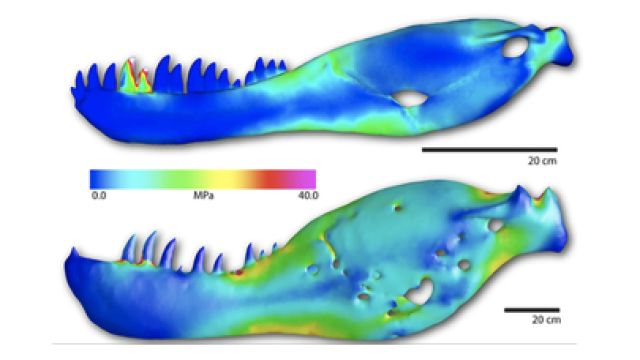Researchers use 3D modelling to examine the jaws of different-sized tyrannosaurs.
This resource is best suited to Biology and Physics students in Years 4, 7 and 10 who are learning about adaptations or forces and are interested in dinosaurs like the terrifying T-rex.
Word Count: 432

The fearsome jaws of Tyrannosaurus rex have long captured the popular imagination. Now, a new study from the University of Bristol, UK, has revealed a more nuanced picture of that famous bite, showing that juvenile T-Rexes lacked the powerful bite force of their adult counterparts, and probably hunted different kinds of prey.
The study has been published in The Anatomical Record.
The researchers used 3D modelling and computational studies to look at the mechanics of stress across tyrannosaur mandibles of different sizes, to discover how (and how hard) these dinosaurs could bite.
They found that while an adult T-Rex could easily crush the robust bones of large dinosaur species such as the duckbilled hadrosaur or the Triceratops, juveniles, with their weaker jaws, had to set their sights on smaller prey.
By examining stress at real and equalised sizes, the team found that while juveniles experienced lower absolute stress when biting, adults were better able to cope with the extreme stress of their hefty bite due to their great bulk – and that when adult and juvenile jaws were equalised in size, juveniles were clearly suffering more intense stress while chowing down.
It’s from these mechanics that the team inferred the difference between adult and juvenile prey types.
“Based on biomechanical data, we presume that [juvenile tyrannosaurids] pursued smaller prey and fulfilled an environmental role similar to the ‘raptor’ dinosaurs such as the dromaeosaurs,” says Andre Rowe, lead author of the paper.
Among other discoveries, the researchers found that the adult T-Rex could deliver a bite with a force of 60,000 Newtons. By comparison, adult lion bites are a relatively measly 1,300 Newtons.

They also found, based on the tension of the lower pterygoid muscle – the muscle that controls mastication and the opening and closing of the jaw – that the force of that extraordinarily powerful bite was concentrated at the front end of a tyrannosaur jaw, in contrast with crocodiles, whose bite force is strongest at the back of the mandible.
Computer modelling of the kind used offers researchers the tantalising opportunity to encounter long-extinct creatures in all their dynamic glory, as moving beings rather than collections of mineralised bones.
The team hope their research will help promote the use of this type of modelling in palaeontology – they are especially keen to see more CT and surface scanning of dinosaur craniums and more application of 3D modelling more broadly in dinosaur studies.
“The current lack of 3D model availability is noticeable in dinosaur research,” says Rowe. “There is still much work to be done concerning skull function in all extinct animals – not only dinosaurs.”

This article is republished from Cosmos. Read the original article here.
Login or Sign up for FREE to download the educational resources






